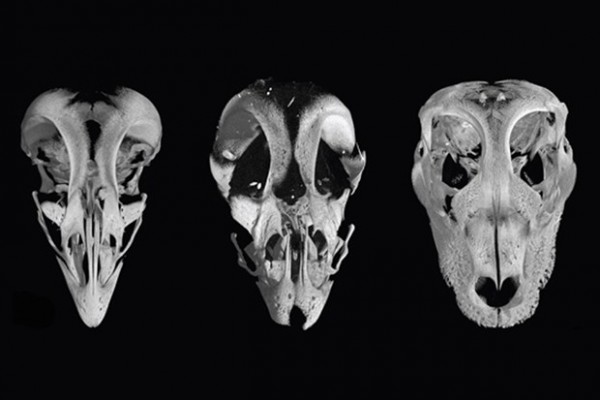Scientists Reveal the Origin of Birds' Beak
| Marco Foronda | | May 13, 2015 03:00 AM EDT |
(Photo : Bhart-Anjan Bhullar) The skull of a chicken embryo ready to hatch usually has a beak (left), but when certain proteins are blocked (middle) develops a reptilian 'snout' from two bones, rather like a modern-day alligator (right).
By genetically altering chickens to grow dinosaur-like snouts, scientists were able to gain some insight into how modern birds' beaks evolved.
Arhat Abzhanov, an evolutionary biologist at Harvard University, says that the ancestors of birds are a group of dinosaurs that includes the famous velociraptor.This group of meat-eaters had long snouts, small brains and eyes, and lots of teeth. Somehow they transformed into birds, which have none of those things.
Like Us on Facebook
"There are between 10,000 and 20,000 species of birds alive today, at least twice as many as the total number of mammal species, and so in many ways it is still the Age of Dinosaurs," said Bhart-Anjan Bhullar, another member of the research team at Yale University.
The beak became the focus of study because of how it differs depending on the kind of bird and how it is unlike the rest of the animal's skeleton.
In particular, the team is interested in birds' distinctive beak, which Bhullar calls "this insane sort of snout that they have."
In discovering the origin of the beak, the researchers have been studying various kinds of animal embryos, from birds like emus and chickens to nonbird reptiles like alligators, which are birds' closest living relatives.
Their work led them to two specific genes. These genes are active in the middle of the face-forming region of bird embryos, but not in the middle of that region in the embryos of other animals.
The team did an experiment to see what would happen if they blocked the effect of that localized gene activity in chicken embryos.
Recent research sequenced 48 bird species, including the budgerigar, the barn owl and the American flamingo.
"The beak is a crucial part of the avian feeding apparatus, and is the component of the avian skeleton that has perhaps diversified most extensively and most radically - consider flamingos, parrots, hawks, pelicans, and hummingbirds, among others,” Bhullar added.
A report on the study appears this week in the journal Evolution. But don't expect the scientists to create lab-grown dinosaurs — that would be a whole lot harder than just trying to restore some of the traits that existed in the first birds.
TagsScientists Reveal the Origin of Birds' Beak, beak, bird, snout. Age of Dinosaurs
©2015 Chinatopix All rights reserved. Do not reproduce without permission
EDITOR'S PICKS
-

Did the Trump administration just announce plans for a trade war with ‘hostile’ China and Russia?
-

US Senate passes Taiwan travel bill slammed by China
-

As Yan Sihong’s family grieves, here are other Chinese students who went missing abroad. Some have never been found
-

Beijing blasts Western critics who ‘smear China’ with the term sharp power
-

China Envoy Seeks to Defuse Tensions With U.S. as a Trade War Brews
-

Singapore's Deputy PM Provides Bitcoin Vote of Confidence Amid China's Blanket Bans
-

China warns investors over risks in overseas virtual currency trading
-

Chinese government most trustworthy: survey
-

Kashima Antlers On Course For Back-To-Back Titles
MOST POPULAR
LATEST NEWS
Zhou Yongkang: China's Former Security Chief Sentenced to Life in Prison

China's former Chief of the Ministry of Public Security, Zhou Yongkang, has been given a life sentence after he was found guilty of abusing his office, bribery and deliberately ... Full Article
TRENDING STORY

China Pork Prices Expected to Stabilize As The Supplies Recover

Elephone P9000 Smartphone is now on Sale on Amazon India

There's a Big Chance Cliffhangers Won't Still Be Resolved When Grey's Anatomy Season 13 Returns

Supreme Court Ruled on Samsung vs Apple Dispute for Patent Infringement

Microsoft Surface Pro 5 Rumors and Release Date: What is the Latest?










